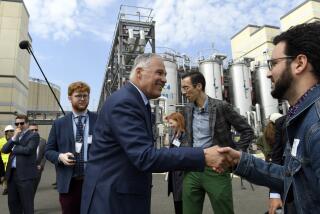Clean Cars Without Voodoo
If the state Air Resources Board and the nation’s auto makers do their jobs right, the cars and sport-utility vehicles that Americans drive 10 years from now will be better, smarter, safer and more fuel-efficient than today’s models. They will not be much more expensive. And they will make a significant contribution to the nascent battle against global warming.
The auto industry and its allies spent $5 million in a sky-is-falling campaign against Assembly Bill 1493, by Assemblywoman Fran Pavley (D-Agoura Hills), which requires the Air Resources Board to set limits on car and truck emissions of greenhouse gases, primarily carbon dioxide, for the first time. The bill passed the Legislature narrowly and was signed into law Monday by Gov. Gray Davis in dual ceremonies in Los Angeles and San Francisco. It sets up the first significant U.S. program specifically aimed at emissions that contribute to global warming.
Auto makers tried everything to thwart it. They pooh-poohed the dangers of global warming. They claimed that SUVs and pickup trucks would be replaced by flimsy little vehicles that would endanger soccer moms and their kids. Bureaucrats would design your car and tell you what you could or could not buy.
Davis was correct when he said, “We’re merely asking business to do what business does best: innovate, compete, find solutions to problems and do it in a way that strengthens the economy.”
The technology needed to meet new standards is available today. Some of it is in use in Europe, Japan and, to a limited degree, the United States. Advances include more efficient transmissions, smoother-rolling tires, tighter seals on air conditioners, better valve exhaust systems and better aerodynamics. High-mileage autos using both gasoline and electricity are already on the road.
But the industry need not be limited to existing technology. Whatever happened to American inventiveness? If we can build a stealth bomber of new composite materials, why can’t Detroit come up with new alloys or synthetics that would make vehicles lighter but stronger and safer? If we could walk on the moon 33 years ago why can’t we build a car or pickup that meets our present needs?
One Silicon Valley executive says AB 1493 is just what the high-tech industry needs to boost the economy. If computer whizzes can revolutionize their industry every few years, why does the internal combustion engine have the same basic design it had a century ago?
The industry has until the 2009 model year to produce vehicles that respond to new standards. This nation went from Alan Shepard’s primitive 15-minute skimming of outer space to the landing of Apollo 11’s Eagle on the moon in little more time than that.






